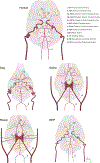Comparison of Large Animal Models for Acute Ischemic Stroke: Which Model to Use?
- PMID: 35164533
- PMCID: PMC10962757
- DOI: 10.1161/STROKEAHA.121.036050
Comparison of Large Animal Models for Acute Ischemic Stroke: Which Model to Use?
Abstract
Translation of acute ischemic stroke research to the clinical setting remains limited over the last few decades with only one drug, recombinant tissue-type plasminogen activator, successfully completing the path from experimental study to clinical practice. To improve the selection of experimental treatments before testing in clinical studies, the use of large gyrencephalic animal models of acute ischemic stroke has been recommended. Currently, these models include, among others, dogs, swine, sheep, and nonhuman primates that closely emulate aspects of the human setting of brain ischemia and reperfusion. Species-specific characteristics, such as the cerebrovascular architecture or pathophysiology of thrombotic/ischemic processes, significantly influence the suitability of a model to address specific research questions. In this article, we review key characteristics of the main large animal models used in translational studies of acute ischemic stroke, regarding (1) anatomy and physiology of the cerebral vasculature, including brain morphology, coagulation characteristics, and immune function; (2) ischemic stroke modeling, including vessel occlusion approaches, reproducibility of infarct size, procedural complications, and functional outcome assessment; and (3) implementation aspects, including ethics, logistics, and costs. This review specifically aims to facilitate the selection of the appropriate large animal model for studies on acute ischemic stroke, based on specific research questions and large animal model characteristics.
Keywords: brain ischemia; dogs; models, animal; sheep; stroke; swine.
Figures



Similar articles
-
Trial design and reporting standards for intra-arterial cerebral thrombolysis for acute ischemic stroke.Stroke. 2003 Aug;34(8):e109-37. doi: 10.1161/01.STR.0000082721.62796.09. Epub 2003 Jul 17. Stroke. 2003. PMID: 12869717
-
Improving the translation of animal ischemic stroke studies to humans.Metab Brain Dis. 2015 Apr;30(2):461-7. doi: 10.1007/s11011-014-9499-2. Epub 2014 Feb 15. Metab Brain Dis. 2015. PMID: 24526567 Free PMC article. Review.
-
Improving Large Animal Ischemic Stroke Models for Translational Studies in the Era of Recanalization.Stroke. 2023 Jan;54(1):e16-e19. doi: 10.1161/STROKEAHA.122.041354. Epub 2022 Dec 12. Stroke. 2023. PMID: 36503265 Review.
-
Large animal ischemic stroke models: replicating human stroke pathophysiology.Neural Regen Res. 2020 Aug;15(8):1377-1387. doi: 10.4103/1673-5374.274324. Neural Regen Res. 2020. PMID: 31997796 Free PMC article. Review.
-
Acute ischemic stroke: overview of major experimental rodent models, pathophysiology, and therapy of focal cerebral ischemia.Pharmacol Biochem Behav. 2007 May;87(1):179-97. doi: 10.1016/j.pbb.2007.04.015. Epub 2007 May 4. Pharmacol Biochem Behav. 2007. PMID: 17521716 Review.
Cited by
-
Long lasting argon neuroprotection in a non-human primate model of transient endovascular ischemic stroke.J Cereb Blood Flow Metab. 2025 Apr;45(4):643-654. doi: 10.1177/0271678X241297798. Epub 2024 Dec 4. J Cereb Blood Flow Metab. 2025. PMID: 39628320 Free PMC article.
-
Tanshinone IIA-Loaded Nanoparticle and Neural Stem Cell Therapy Enhances Recovery in a Pig Ischemic Stroke Model.Stem Cells Transl Med. 2022 Oct 21;11(10):1061-1071. doi: 10.1093/stcltm/szac062. Stem Cells Transl Med. 2022. PMID: 36124817 Free PMC article.
-
Blood-brain barrier repair: potential and challenges of stem cells and exosomes in stroke treatment.Front Cell Neurosci. 2025 Apr 7;19:1536028. doi: 10.3389/fncel.2025.1536028. eCollection 2025. Front Cell Neurosci. 2025. PMID: 40260076 Free PMC article. Review.
-
Feasibility of Deuterium Metabolic Magnetic Resonance Spectroscopy for the Investigation of Ischemia and Reperfusion in Rat Brain Slices Perfused Ex Vivo.NMR Biomed. 2025 Sep;38(9):e70115. doi: 10.1002/nbm.70115. NMR Biomed. 2025. PMID: 40820229 Free PMC article.
-
Effect and mechanisms of resveratrol in animal models of ischemic stroke: A systematic review and Bayesian meta-analysis.J Cereb Blood Flow Metab. 2023 Dec;43(12):2013-2028. doi: 10.1177/0271678X231206236. Epub 2023 Oct 6. J Cereb Blood Flow Metab. 2023. PMID: 37802493 Free PMC article.
References
Publication types
MeSH terms
Substances
Grants and funding
LinkOut - more resources
Full Text Sources
Medical

